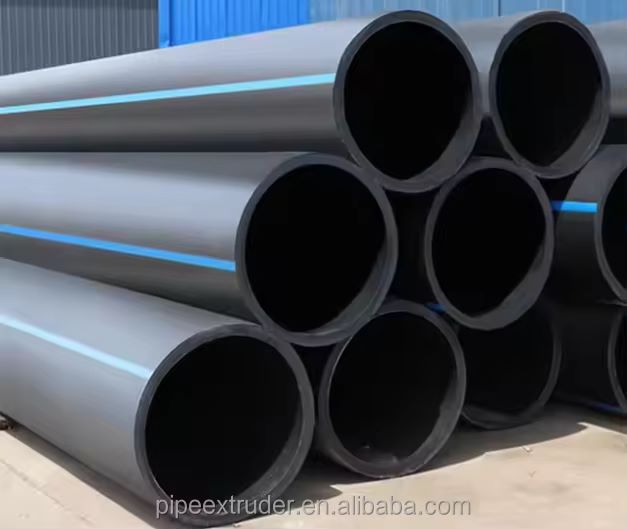Working principle of pipe heater of HDPE pipe welding machine
2025-06-23
The pipe heater is a crucial component in an HDPE (High-Density Polyethylene) pipe welding machine, commonly used in the fusion welding process for joining HDPE pipes. This process, known as butt fusion, involves heating the ends of two pipes to a specified temperature and then joining them under pressure to form a strong, durable bond. The pipe heater is responsible for evenly heating the pipe ends to the correct temperature, ensuring a reliable and uniform weld. Below is an essay outlining the working principle of the pipe heater in an HDPE pipe welding machine.
Working Principle of the Pipe Heater in an HDPE Pipe Welding Machine
Introduction
In the realm of HDPE pipe welding, ensuring the reliability and integrity of pipe joints is essential. The pipe heater is a pivotal part of this process. It works by transferring heat to the pipe ends, making them pliable for fusion. The precise temperature control of the heater is fundamental to achieving a perfect fusion bond. A malfunction or improper heating can lead to weak joints and possible failures in the pipeline.
Key Function of the Pipe Heater
The primary function of the pipe heater is to heat the pipe ends to a specific temperature, usually between 200°C to 220°C (392°F to 428°F), depending on the HDPE material grade. This is achieved through the use of electric heating elements embedded in the heater's surface. The heater provides a controlled environment where the ends of the pipes are heated evenly, ensuring the surface is soft and ready for fusion.
Working Mechanism
Preheating Phase: The heater is first placed between the two pipe ends that are aligned for fusion. It is important that the pipe ends are clean and free of contaminants, as impurities can affect the weld quality. The machine is set to the desired temperature, and the heater begins its preheating function. It uses electric resistance or infrared heating elements, which emit heat onto the surface of the pipe ends.
Temperature Control: Modern pipe heaters are equipped with advanced temperature control systems that monitor and regulate the temperature of the heating elements. A temperature sensor (typically a thermocouple or infrared sensor) is integrated into the heater. It constantly checks the pipe temperature to ensure it remains within the optimal range, typically around 210°C. This is crucial to avoid overheating or underheating the pipe ends, which can lead to poor fusion and joint strength.
Heat Transfer to Pipe Ends: Heat is transferred through conduction from the heater elements to the pipe surfaces. As the pipe ends absorb the heat, the material becomes soft and begins to melt at the contact points. This allows for the subsequent fusion step, where the softened pipe ends are pressed together under controlled pressure to create a joint.
Uniform Heating: The design of the heater ensures uniform heat distribution. This is achieved through a combination of materials, thermal insulation, and the design of the heating elements. Uniform heating ensures that both pipe ends reach the desired temperature simultaneously, avoiding hot spots or cold spots that could lead to an uneven weld. The pipe heater typically has a cylindrical or ring shape, with heating elements that wrap around the pipe, providing even coverage.
Removal and Fusion: After the pipe ends reach the desired temperature, the heater is automatically or manually removed from the joint area. The two heated pipe ends are then pushed together with a specified force using the machine’s hydraulic or mechanical press. The pressure ensures that the molten material fuses together, forming a strong bond once the joint cools and solidifies.

Important Factors in Pipe Heater Operation
Thermal Efficiency: The pipe heater must operate efficiently to conserve energy and reduce operating costs. A high level of thermal efficiency ensures that the desired temperature is achieved quickly and consistently.
Material Compatibility: The heater must be designed to accommodate the specific properties of HDPE, which has a relatively low melting point compared to other materials. It must also be capable of handling various pipe sizes and wall thicknesses.
Temperature Accuracy: Accurate temperature control is essential. An overshoot in temperature can cause degradation of the HDPE material, weakening the joint, while an undershoot may prevent the pipe from fusing properly.
Safety Mechanisms: Pipe heaters are typically equipped with safety features to protect the system and the operator. These include over-temperature protection, automatic shutoff mechanisms, and emergency stop buttons to prevent accidents.
Conclusion
The pipe heater in an HDPE pipe welding machine plays a vital role in ensuring the quality of the welded joints. Its ability to heat the pipe ends to the correct temperature uniformly and efficiently is crucial for producing strong, durable, and leak-proof connections in the pipeline. Advances in heater design, temperature control, and materials have enhanced the reliability and performance of HDPE pipe welding machines, making them indispensable in industries such as construction, water distribution, and gas pipelines. Proper maintenance of the pipe heater is essential for ensuring the longevity and performance of the welding machine, ultimately ensuring the strength and integrity of HDPE pipe joints.
As a professional manufacturer and supplier, we provide high-quality products. If you are interested in our products or have any questions, please feel free to contact us.


